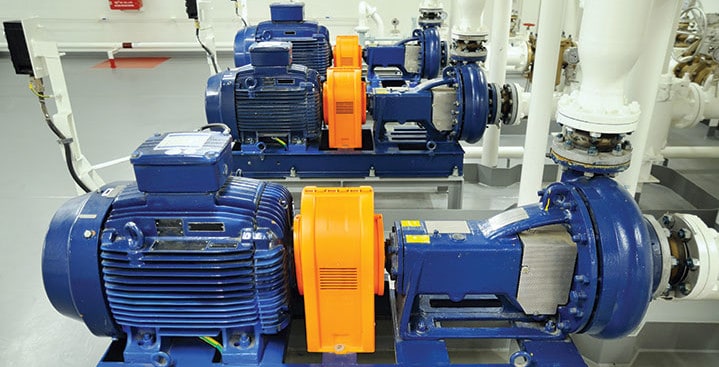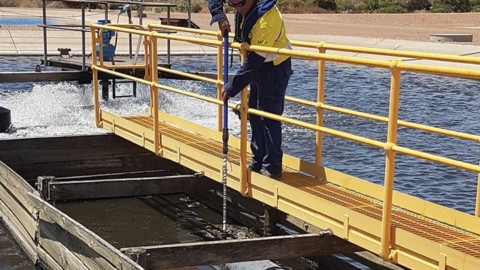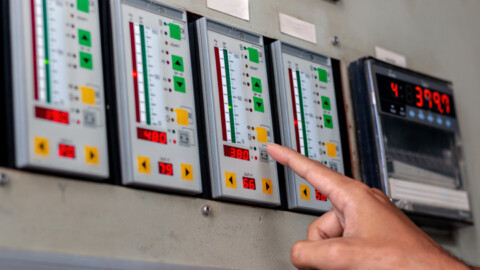An electric motor uses four to 10 times its purchase price in electricity annually.1 When choosing a motor it is essential to consider the operating cost as well as the capital cost. High efficiency motors can cost up to 40 per cent more than standard motors, however, the payback can be less than two years, due to the energy savings. Here, motor and pump efficiencies are discussed as part of the Queensland Government Ecoefficiency for Queensland Manufacturers project.
Instead of rewinding motors, consider replacing them with energy-efficient motors. Often motors are described as “high”, “super” or “premium”. However, to be considered energy-efficient, motors must meet the Australian Minimum Energy Performance Standards (MEPS).
In April 2006, the Australian efficiency levels (AS/NZS 1359 5:2004) were increased so the previous “high efficiency” standards are now standard, and a new more stringent level was created.
The new level was targeted to reduce energy losses by 15 per cent, compared to the 2001 MEPS.3
Table 1: Payback periods for purchasing high efficiency motors2

Assumptions: Pole 4 and average energy costs per year (10 cents/kWh).
Use a correctly sized motor
Avoid purchasing oversized motors to cater for future production increases or to override load fluctuations. Table 2 illustrates the energy losses and associated costs of an oversized motor.
Table 2: Cost comparison for an oversized motor4

Assumptions: Operating 6000 hours/year, electricity costs 10 cents/kWh.
Variable speed drives on oversized motors or for motors dealing with variable loads
Variable speed drives (VSDs) reduce energy consumption by adjusting the motor speed to continually match the load of the equipment, such as pumps, fans and compressors. The financial viability of installing a VSD depends on the motor application and operating hours. VSDs tend to be most economical on large motors. They also enable “soft starting” to prevent the electrical system overloading, which drops the voltage and affects other equipment.5
Energy consumed by fans and pumps is proportional to the cube of the motor speed. If a VSD reduced the speed by 20 per cent, the power consumed would drop by 49 per cent.6
Multiple speed motors or multiple smaller motors
Where a variable speed drive is too expensive, or the motor is so oversized that the variable speed controller would operate at very low speeds, reducing the useful life of motors and other equipment, consider one of the following:
- Using a multi-speed motor that can operate at a number of different speeds
- Installing several smaller motors with controls that switch on only enough motors to meet the demand
Keep motors well maintained7
- Keep motors clean of dirt and grease, especially fans on fan-cooled motors
- Excessive vibration may be a sign of motor misalignment
- Make sure no connections or wires are loose or damaged
- Check motor bearings
Power factor correction
Induction motors, magnetic ballasts and transformers require two types of power:
- Active power – produces work or heat and is expressed in kilowatts
- Reactive power – generates magnetic fields and is expressed as kilovolts-amps reactive (kVARs)
Total power is the vector sum of these two powers and is measured in kilovolts-amps (kVA).
Power factor is the ratio of active power to total power and is expressed as a number between zero and one (perfect score). The figure below demonstrates this graphically.
For example:

This indicates that only 70 per cent of the current provided by the electrical utility is being used to produce useful work.
Motors in food processing
Plants that operate with a low power factor require the power company to feed much more power into the distribution system so the plant can operate its equipment and appliances. Power companies in other states of Australia usually charge an additional fee to food processing plants with poor power factors (e.g. 0.6) to capture costs not reflected by the electrical (kWh) meter. While Queensland power charges are based only on active power consumption, this is likely to change in the future.
Poor power factors cause extra current flows, increase the chances of cables overheating, reduce equipment reliability, increase supply costs, and result in additional greenhouse gas emissions.
Power suppliers or consultants can assist in power factor correction options which include:
- Power factor correction capacitors designed to provide reactive current
- Automatic power correction equipment or banks of capacitors that are switched on and off-line depending on the power factor
- Replacing oversized motors that are lightly loaded, or idling, with smaller motors
- Installing high power factor lighting and electronic equipment
- Pumps are often not run at their optimal design efficiency, as dampers, throttling and pressure relief valves and bypass systems restrict flow.
A unit of energy saved at the pump or fan saves 3.3 units at the motor.8
Improving the efficiency of pumps and fans will not only save energy but will also reduce maintenance, extend the life of the equipment, and reduce noise.
Careful pump, fan, motor and pipework selection
Avoid oversizing fans or pumps
Pumps and fans are often oversized due to uncertainty of the plant’s requirements or to accommodate future expansion.
Pumps are also often oversized to cater for gradual increases in pipe flow resistance, due to roughness increases or scaling. A pump that is oversized will have an operating head and/or flow rate far greater than the plant’s requirements, and will need constant throttling. Similarly, an oversized fan will waste energy unnecessarily.
The benefits of correct pump sizing
For example, a food processing plant requires 1,500 tonnes of refrigeration during three months in summer but only 425 tonnes for the remaining nine months. The process uses two chilled water pumps operating at 13,411m3/h (149kW each) that are both used in summer but two-thirds of the flow rate is bypassed during the remaining nine months.
By replacing one of the pumps with a new 5,504m3/h (37kW) pump designed to have the same discharge head but requiring only 37kW and running only the older pump in the summer, the plant would save 790,520 kWh a year or $79,052 (based on 10c per kWh).9
Well-designed and sized pipework
Friction losses can be reduced by reducing the number of bends and valves in pipework. It is also important to ensure the diameter of the pipework is not too small, thereby creating additional load on the pump, motor and fans. In some cases the type of material used in pipework can also reduce friction losses.
Trim impellers on oversized pumps
The impeller can be trimmed if a pump is continuously throttled to 10 per cent less than its design flow rate or the bypass valves are continually open, indicating excess flow. Trimming involves machining the impeller to reduce its diameter, which reduces the amount of energy it imparts to the pumped fluid.
Operate pumps and fans only when required
Automatic controls can be used to limit the operation of pumps and fans to only when needed.
Close the loop on liquid-seal vacuum pumps
Pumps such as liquid-ring pumps use water as a sealing and cooling medium. Some uses for vacuum pumps in food processing plants include dryers, packing machines and evaporative coolers. The water is typically sent to a drain.
Recirculating water, or closing the loop, on this once-through use can save significant amounts of water and reduce wastewater volumes. If the water cannot be recirculated, investigate the possibility of collecting the water for other purposes such as cleaning. Alternatively, consider mechanical seals that do not require sealing water. Cost savings of more than 50 per cent can be achieved from the reduced water and energy usage.10
For more information on improving energy efficiency for pumps and motors, visit www.ecoefficiency.com.au.
Footnotes:
1. Green House Office, 2003, Motor Solutions Online – Selecting the Best Motor and Equipment
2. Teco Australia, 2003, Premium Efficiency Motors MAX-E2 Information Brochure
3. Group Instrumentation, 2008, Sustainability Matters–Towards a New Age of Electric Motor Efficiencies
4. US Office of Industrial Technologies Energy Efficiency and Renewable Energy, 2004, Motor Master +4.0 Software
5. Sustainability Victoria, Resource Smart Business – AC Variable Speed Drives
6. US Department of Energy, 2001, Green Federal Facilities An Energy, Environmental, and Economic Resource Guide for Federal Facility Managers and Designers – 5.7.1 High Efficiency Motors
7. US Department of Energy, 2001, 5.7.1 High Efficiency Motors
8. NSW Department of Energy, Utilities and Sustainability, Energy Saving Manual Section 12: Pumps and Fans
9. US Department of Energy, 2005, Industrial Technologies Program – Energy Tips Pumping Systems
10. Sydney Water, 2004, Water, Money and the Environment – Liquid Ring Vacuum Pumps





















